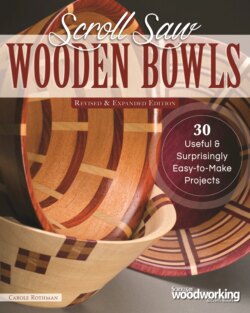Читать книгу Scroll Saw Wooden Bowls, Revised & Expanded Edition - Carole Rothman - Страница 24
Cutting the Rings
ОглавлениеAll the projects in this book are made from concentric rings that are cut at specific angles. These rings can be circular, but they can also be cut in a vast array of profiles, such as ovals, rectangles, and multi-lobed shapes. Beginning projects use patterns that provide cutting lines for each ring. More advanced projects, especially those with rings cut at various angles, use patterns that provide cutting lines for the first ring only; once cut, the first ring serves as the pattern for the second. The second ring serves as the pattern for the third, and the sequence continues until all rings are cut. This method requires precise cutting but gives very good alignment when the rings are stacked. Patterns are usually attached with a temporary bond (repositionable) adhesive. If your design is circular, you can bypass a paper pattern entirely and draw the rings directly on the wood with a good-quality pencil compass.
Marking the bowl
As you make your bowl, you’ll be directed to draw pencil marks of various types on the blank or rings, including registration lines, also referred to as “guidelines.” The type of pencil used can make a difference. Lines drawn with a harder lead are more precise but are lighter in color and more difficult to see. They may also score the wood if too much pressure is applied. Lines drawn with a softer lead are more visible but less precise and can leave graphite particles that penetrate the pores of soft woods like aspen. If you keep a variety of pencils on hand, you can choose the best match for each situation. For dark woods like walnut or teak, you can use a white pencil if precision is not required, as when marking glue spots or indicating ring orientation. Before gluing or sanding areas containing pencil marks, transfer any you’ll still need to adjacent surfaces, then erase the originals.
The useful awl
In this book, the awl is used for several important purposes. The first is to center patterns on the blank, which is done by inserting the point of the awl through the center of the pattern and placing it at the intersection of the guidelines. The second purpose is to create an indentation to keep the drill bit from wandering when drilling an entry hole with an angle guide. Be sure to keep your awl handy while progressing through the projects.
Beginning projects, such as the basic bowl, include a pattern for each ring.
More advanced projects will have a pattern for the first ring only. Each ring will then be used to create the next one.
